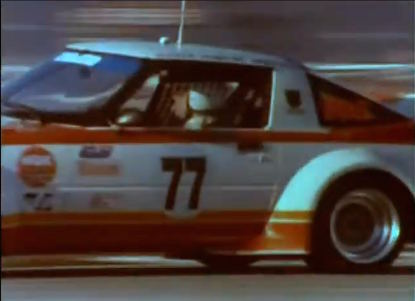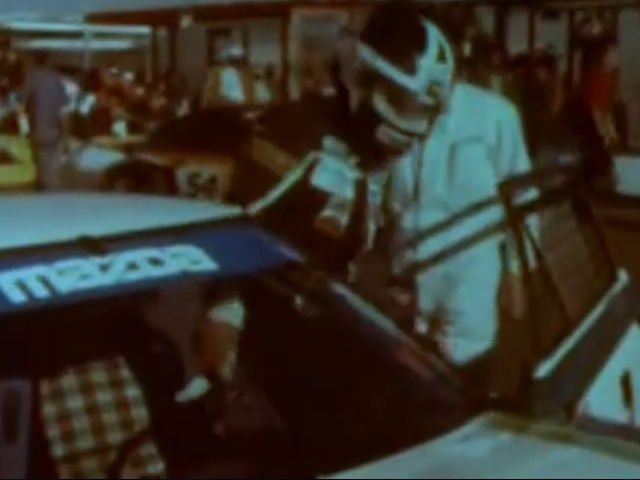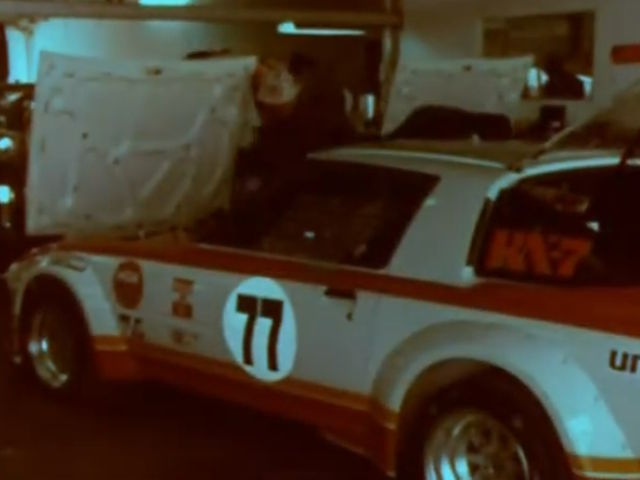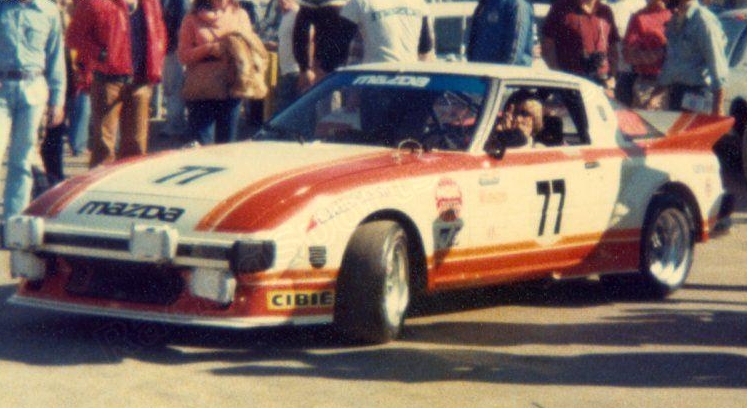 Jump to:
Jump to:
 Jump to:
Jump to:
In January 1979 Mazda Japan sent three race-prepared left-hand drive Rx-7 cars to the USA to prepare for the 18th 'Annual 24 Hour Pepsi Challenge', held at Daytona International Speedway on Feb 4th 1979.
Two cars were entered in GTU class (FIA Group 2, under 2.5ltr engine displacement), the third one was kept as a T-car (spare).
The car with entry number 7 had green stripes over a Racing White base color and was driven by Japanese drivers Yoshimi Katayama, Yojiro Terada and Takashi Yorino, with Katayama being the most experienced driver.
The second car ran with entry number 77, had red/orange stripes over a Racing White base color and was driven by American drivers Walt Bohren, Jim Downing and Roger Mandeville, each experienced IMSA drivers who had raced Mazda Rx-2 and Rx-3 cars before.
The spare car was not given an entry number, it also had red/orange stripes over a Racing White base color.
Engines were tuned 12A rotaries with peripheral intake ports instead of the production engines side intake ports, this lead to some controversy after the race with competitors arguing that these engines belonged in GTX (unlimited) class.
The cars qualified in 32nd (nr.7) and 34th (nr.77) position overall (1st and 2nd in GTU class) out of 67 entries.
The team decided that during the race the nr.7 car was to act as a 'hare' to make the competition go too fast and break, to do so the rev limit for this car was set at 8500rpm.
The nr.77 car was meant to be held back slightly to assure it would finish, therefore its rev limit was set at 8000rpm.
 During the race the nr.7 car experienced problems twice: first a brake caliper seized, later a fuel pump had to be replaced, each repair costing several laps.
During the race the nr.7 car experienced problems twice: first a brake caliper seized, later a fuel pump had to be replaced, each repair costing several laps.
The nr.77 car ran virtually trouble-free which resulted in it overtaking the nr.7 car in the ranking during the night, at lap 400 the nr.77 car was 4th overall, 1st in GTU class and the nr.7 car was 5th overall, 2nd in GTU class.
In the final stages of the race, oil temperature of the nr.77 car became a slight concern, so it was decided to reduce the pace of nr.77, this allowed the nr.7 car to take back the lead in GTU class. Both cars crossed the finish safely in 1st and 2nd place in GTU class, 5th and 6th place overall.
After the race the engines were shipped back to Japan for research, but the cars (now fitted with spare engines) were handed over to American drivers: the nr.7 car went to Mandeville, the nr.77 car went to Bohren and the spare car went to Jerry Wright.
Both Bohren and Mandeville subsequently campaigned their cars in IMSA GTU class during the remainder of the season and the following years. Wright ran his car in West Coast championships.
This explains why neither of the original cars remained in a state similar to how it was at the time of the 1979 Daytona race.
Both the Mazda Museum in Hiroshima Japan and Mazda North America (MaNA) in Irvine CA have an Rx-7 SA racer in their collections in a livery similar to that of the winning nr.7 car, however these are right-hand drive cars. The MaNA car was one of the very first Rx-7 race cars and was used as a development mule for the GTU cars.
The MaNA car was displayed and driven in the USA at the 2010 Rolex Monterey Motorsports Reunion, see links below for pictures.
Most of these pictures are screen shots taken of a Mazda promo film on YouTube, linked below.
The quality of the original film has deteriorated a bit and the pictures have a blue/teal cast, I made no attempts to correct the cast so the colors on these pictures are not reliable.
 |
|---|
| Both cars in the pits box before qualifying. Note that some stickers have yet to be applied, including the 'Powered by ROTARY' sticker on the rear of the spoiler. |
 |
| Installing the race-prepped 12A engine before qualifying. Note the huge peripheral intake ports covered with duct tape. |
 |
| View of the emergency switch mounted on the right-hand sail panel window of each of the cars. Note the white lettering on the knob and the wire running from the switch through the top of the vent. |
 |
| Below the dashboard, to the right of the steering column of each of the cars a CB radio was fitted: an aluminum box with a red 2-digit LED display, a rotary knob and some buttons/switches. |
 |
|---|
| Nr.7 in pit lane, this picture was used by Aoshima for the box art of their Rx-7 racer kit. |
 |
| Katayama getting into car Nr.7. Note the checkered seat pattern and the black border around the window net. |
 |
| Car Nr.7 at dawn. |
| picture found on www.lemans-models.nl (no longer online) |
 |
| Yorino driving off after a nightly pits stop. Note the white borders around the driver name stickers. |
 |
| Pit stop at dawn, Yorino at the wheel. Note the extended switch lever at the center of the dashboard, the shiny wooden shift knob and the location of the CB radio below the dashboard. |
 |
| Deciphering the 'Powered by...' lettering on the rear. The decal in the Hasegawa kit reads 'ROTALY', but if the actual sticker would have read 'ROTALY', then the gap between the top of the 'Y' and the letter preceding it would have been wider. |
 |
| View of the roof light and the antenna of the Nr.7 car. The lens of the Nr.7 cars roof light was green; Nr.77 roof light lens was white. |
 |
|---|
| Nr.77 in the pits box before qualifying. This picture nicely shows that the white balls behind the race numbers were retroflective. |
 |
| Nr.77 in the paddock before the race. |
| picture found on www.lemans-models.nl (no longer online) |
 |
| Early in the race, loaded with fuel, high-beam lights still covered up. Look at that amount of body roll ! |
 |
| Taking off after a nightly pits stop, head lights being switched on. Note that there are no black bezels fitted to the pop-up lights and that the light units are larger than stock. The insert shows all of the lights the Nr.77 lit during the night, the innermost pair of high-beam lights was kept switched off. |
 |
| Pits stop of Nr.77 at dawn, Jim Downing at the wheel. |
 |
| Pits stop at dawn. View of the rear, showing that Nr.77 also carried a red "Powered by ROTARY" sticker on its spoiler during the race. |